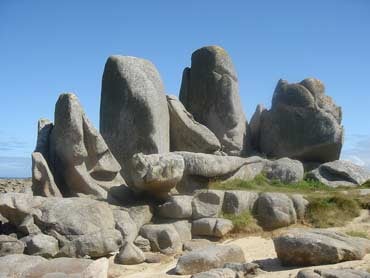Brittany’s Butter Bonanza

Of all the regions in France, one of the most peculiar is Brittany. The cuisine is hearty, earthy, and dynamic – like the terrain. The coastline is a virtual lunar landscape of jutting rock formations, with pristine beaches (with somewhat frosty water) tucked in between them. Consequently, upper Brittany is somewhat remote and not a popular tourist destination. Most of my days begin at an almost-deserted beach with a dip in a frigid, clear water, and finish at a lively crêperie, picking through a mound of moules frites, steaming-hot mussels simmered with white wine and local shallots served with a overly-generous pile of frites that I always think that I’d never be able to finish. (But, of course, I do.)
Ah, summer vacation in Brittany. There’s not much to do here except swim in the chilly water, and eat seafood, red onions (more about them in a later post), and spread the delicious salted butter on everything that I can.
Unlike the rest of France, the Bretons don’t eat much cheese…in fact, there are no local cheeses that I can think of that are produced in the region and I didn’t see one fromagerie in the entire ten days of our trip. But they make up for it by offering up lots of butter, which they’re justifiably famous for. When you compliment a local pastry shop or restaurant on their cuisine, they will invariably respond proudly, “C’est la beurre de Bretagne!”

There’s also not so much wine wine consumed either. The locals favor sparkling, lightly-alcoholic apple cider. A fizzy bottle is popped open before each meal and served in traditional bolées, similar to a squat coffee cup with a handle.
But back to the butter—it’s the best I’ve ever tasted. Breton butter is notable since it’s almost always flecked with large, coarse grains of salt that crunch when you bite into them. Much of the salt used is harvested on ponds and marshes in the Guérande, where the famed fleur de sel is harvested as well. And unlike the rest of France, people in Brittany often butter rye bread, that’s served with oysters. (So next time you’re in Paris and that waiter gives you a quizzical look when you ask for butter, tell him that you’re from Brittany.)

Naturally much of this butter makes its way into buckwheat crêpes, or galettes de blé noir (when made with buckwheat flour, or blé noir, they’re normally called galettes rather than crêpes. You can buy crêpes at most of the local pastry shops, and if you’re lucky, they’re still warm.
One night I picked up a stack and for simple dessert, I heated a bottle of hard apple cider in a skillet, added a handful of unrefined cassonade sugar, a modest knob of Breton salted butter and some delicious prunes from Gascony. Once the cider was sweet and syrupy, I added some folded crêpes, a pour of Calvados, and voila!
Perhaps the most famous dessert of the region is the Far Breton. Far is the Breton word for ‘custard’, and the Far Breton is remarkably similar to a custard tart sans the crust. Like everything, there are good versions, and not-so-good versions (like pretzels on the streets of Manhattan). You’ll find Far Breton everywhere in Brittany; in supermarkets, outdoor markets, restaurants, and pastry shops. Like flan in Paris (which is a wedge of custard tart, and not the inverted caramel custard that many of us are used to,) a slab of Far Breton with prunes is often a mid-afternoons snack, or le goûter for hungry folks.
Although I find most of them rather dense and heavy, I knew that if I tried as many as possible like Goldilocks, I would certainly find the version that was “just right”. And sure enough, the best was from a pastry shop in Lesneven called Labbé, a few steps off the main square.

Another extraordinary treat is the Kouign amann, which is pronounced (and spelled) a few different ways, depending on your accent.

A friend who visited Brittany once wrote me and said, “A stick of butter would seem light in comparison!..” when describing his first encounter withKouign amann. And indeed, the word amann is the Breton word for butter.
I had to try one from several bakeries, since it’s one of my favorite desserts: layers of flaky pastry baked with plenty of salted butter and sugar, until it’s all dark, crisp, and caramelized? Bring it on. Sometimes they’ll sell it by the slab at outdoor markets, and they slice off a hunk for you and sell it by the kilo. But the best thing I ate all week was…

Ok, I know what you’re thinking. Here I was surrounded by fabulous buttery creations, but then I discovered strawberries from Plougastel. But honestly, these were the best strawberries I’ve ever had. Although usually I judge fruit based on its aroma before I buy (and these had little smell), these looked so ruby-red and glistening, that I just had to try them. Each one was sweet-sweet-sweet! Each was juicy with flavor, like a soft piece of sweet strawberry candy and deep red all the way through. I’ve never had strawberries like that before, although I’ve seen them in the markets in Paris, they never looked so appealing as they did at that village fruit market in Brittany.
Related Links and Posts
Allegedly the Birthplace of Kouign Amann
Larnicol: Kouign Amann in Paris
















